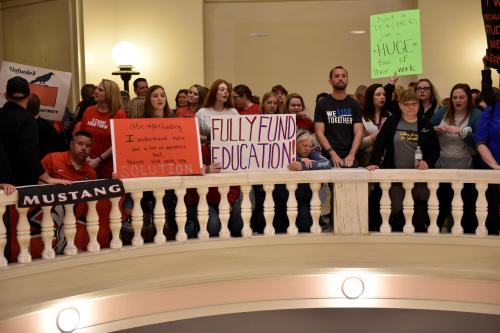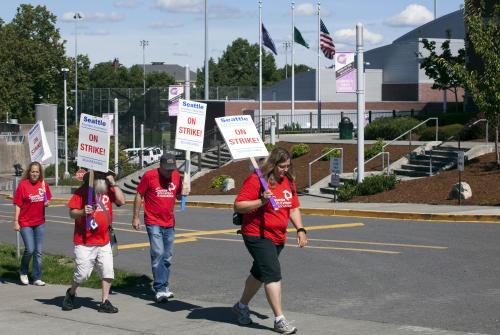Tens of thousands of public school teachers have been involved in teacher strikes and protests spanning four states in the past two months. Though West Virginia’s disputes resolved early last month and Oklahoma’s walkout just ended, tensions are still simmering in Arizona and Kentucky.
Last week, I offered my take on some of the underlying factors lurking behind the teacher strikes. Importantly, the commonalities between these striking states are also shared by other states, and in this post I’ll do a quick analysis that may indicate where conditions are ripe for future actions. Based on this analysis, Southern states share many of the features that characterize states where we’ve seen recent strikes.
Let’s consider the four economic factors that I suspect are behind the teacher unrest:
- Low average teacher salaries in comparison to the national average: Because many states have been citing statistics from a report produced by the National Education Association, the largest teachers union, we’ll also use these rankings (even though the numbers differ slightly from official sources for the same school year).
- Reductions in inflation-adjusted teacher salaries since the onset of the Great Recession: Nationally, average teacher salaries are down nearly 5 percent after inflation is considered, and some states are down even further. We take data for this calculation from the 2017 Digest of Education Statistics, comparing the most recent data with 2009-10.
- Reductions in per-pupil spending since the onset of the Great Recession: According to a report from the Center on Budget and Policy Priorities last year, school funding in 29 states had not returned to pre-recession levels through the 2015 fiscal year.
- State-determined salary schedules: Though not an obvious factor, I believe this is an important common feature of the current teacher strikes, as having salaries determined by the state focuses any public protests on a single target in the state Capitol, rather than peppering small demonstrations across many local administration offices. Fifteen states determine some form of minimum salary schedules for their teachers, according to the National Council on Teacher Quality’s Teacher Contract Database. It is worth noting this feature of policymaking does have a high degree of overlap with right-to-work laws (12 of the 15 states are also right-to-work states).
Here are the results for how each of the four striking states scored on these economic factors.
| State | Average Teacher Salary Ranking | Change in inflation-adjusted salaries | Change in per-pupil state spending | State-determined salary schedules |
| Arizona | 43 | -9.8% | -36.6% | No |
| Kentucky | 26 | -5.6% | -5.9% | Yes |
| Oklahoma | 49 | -15.2% | -15.6% | Yes |
| West Virginia | 48 | -11.1% | 3.6% | Yes |
As can be seen in the table, the striking states share many of these characteristics. Also, characteristics in one state that seem out of step with other striking states correspond to some of the real differences that we’re seeing across the teacher strikes. For example, Kentucky teachers’ salaries are essentially in the middle of the pack nationally, and it is the one strike where teachers are not advocating for higher salaries but against changes to the state’s pension benefit calculation. Also, consider how teachers in both Oklahoma and Arizona have been tying demands for education funding with their demands for salary increases, where this was not part of what motivated teachers in West Virginia. Teachers in Arizona have not actually gone on strike, but have organized protests only.
The next states for Possible action
So what other states have favorable economic conditions for a statewide teacher strike, based on the characteristics of the four states involved in the current strikes and protests? If we consider these conditions as possible risk factors, then both Mississippi and North Carolina appear to be particularly at risk, with Mississippi showing slightly more unfavorable conditions for teachers.
| State | Average Teacher Salary Ranking | Change in inflation-adjusted salaries | Change in per-pupil state spending | State-determined salary schedules |
| Mississippi | 50 | -16.0% | -12.4% | Yes |
| North Carolina | 41 | -5.0% | -12.2% | Yes |
Several other states, however, share these economic factors and thus may also be at risk.
| State | Average Teacher Salary Ranking | Change in inflation-adjusted salaries | Change in per-pupil state spending | State-determined salary schedules |
| Alabama | 37 | -8.20% | -21.60% | Yes |
| Georgia | 23 | -8.20% | -16.60% | Yes |
| Idaho | 47 | -8.30% | -18.00% | No |
| New Mexico | 44 | -8.30% | -11.70% | No |
| South Carolina | 36 | -8.60% | -11.90% | Yes |
| South Dakota | 51 | -1.90% | -11.80% | No |
| Utah | 45 | -8.00% | -14.60% | No |
This list includes three Southern states, all of which have modest to low levels of teacher pay, deterioration in both salaries and general education funding over the last decade, and state-determined salary schedules. Combining these three states with the two shortlist states above suggests that teachers in much of the South endure conditions similar to states where teachers have already organized.
This final list also includes four states that do not have state-determined salary schedules. As I suspect, this feature is one that helps galvanize teacher and media attention on a broad scale, I believe organizing a statewide strike would be a logistical challenge in these states. Yet, this should not preclude teachers from organizing protests and perhaps striking in some districts as economic conditions are generally unfavorable to teachers in these states.
Could future strikes really happen in other states?
Whether strikes will come to fruition in any of these states, or any other for that matter, is hard to predict due to the variable contexts across the country. The four economic factors highlighted here are insufficient to explain what has happened in these states, as current tax and school finance policies, partisan divides, union influence, and many other state-level features contributed to the strikes that are now happening. Therefore, these myriad factors would also be important in understanding which states actually witness teacher unrest in the near future.
Despite the complexity of predicting where the next strike might occur, the multi-state teacher actions have certainly prompted discussions in other schools beyond their border. In recent days, rumors of gathering calls for action have been reported in Indiana and Texas. Further teacher action in North Carolina seems almost inevitable, with a call for a march on the state Capitol set for a date next month. These conversations are not just happening among teachers in other states, but some state legislatures (including several on my list) have begun making moves in recent months to pay teachers more. Given the recent timing of their actions, they were likely motivated at least in part by the teacher victory in West Virginia. Yet, only time will tell if these moves are enough to forestall future demands for more.
Also, quite a few of these states have been dealing with teacher shortages and other difficulties with recruiting and maintaining a quality workforce—an expected byproduct of low salaries. Perhaps teachers in these states could use this apparent need for good teachers as leverage to bring state legislators to the bargaining table.
Lawmakers, education leaders, and the public need to pay attention. Based on what we can infer from other research, weak teacher workforces often disproportionately harm disadvantaged student groups. Without remedying teacher pay and benefits, the quality of the teacher workforce and the pipeline leading to it will continue to suffer in not just those states that are striking but in all states where teacher and educational conditions are weak.
Max Rombado contributed to this post.
The Brookings Institution is committed to quality, independence, and impact.
We are supported by a diverse array of funders. In line with our values and policies, each Brookings publication represents the sole views of its author(s).








Commentary
Which states might experience the next wave of teacher strikes?
April 13, 2018